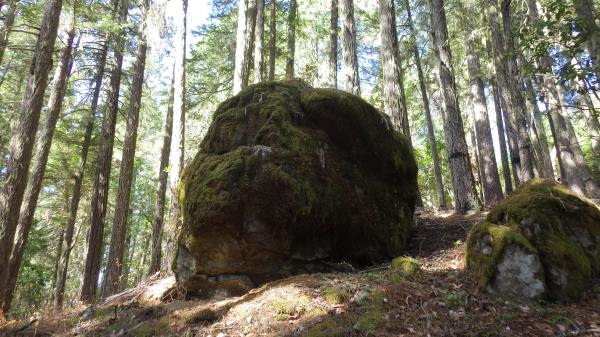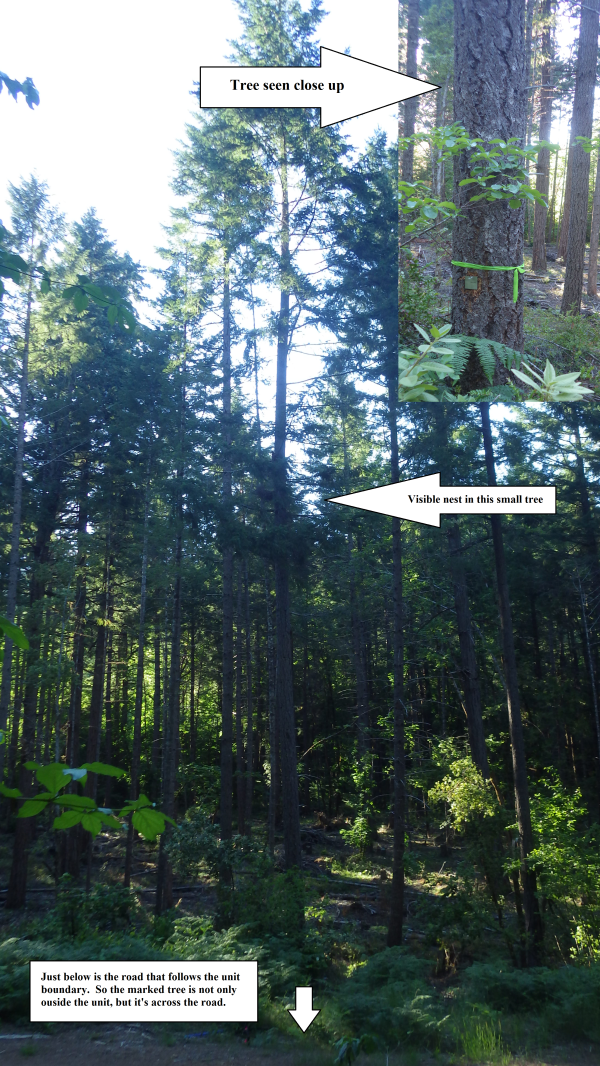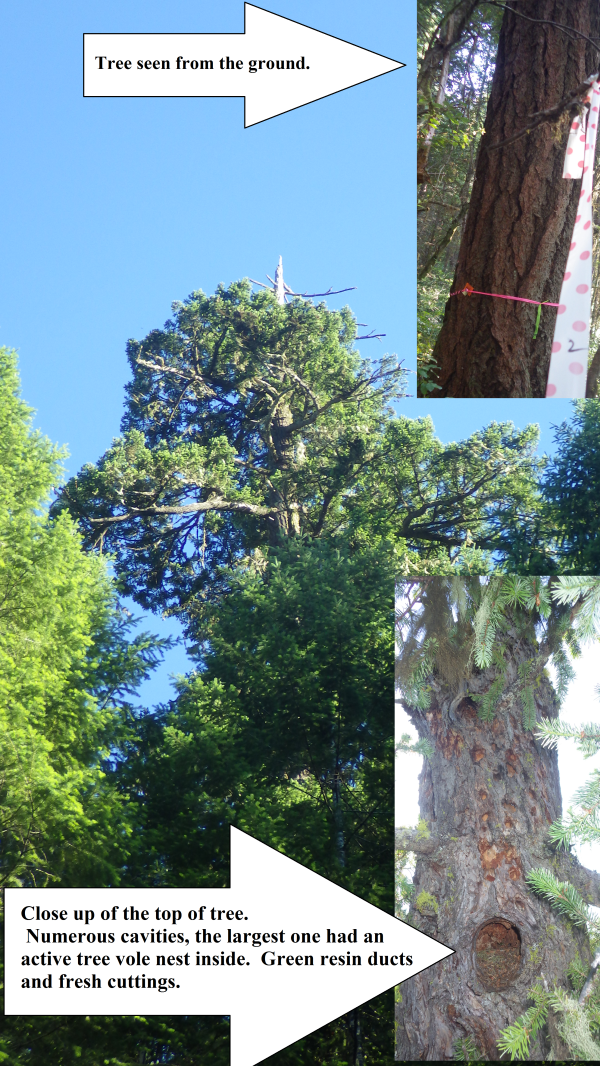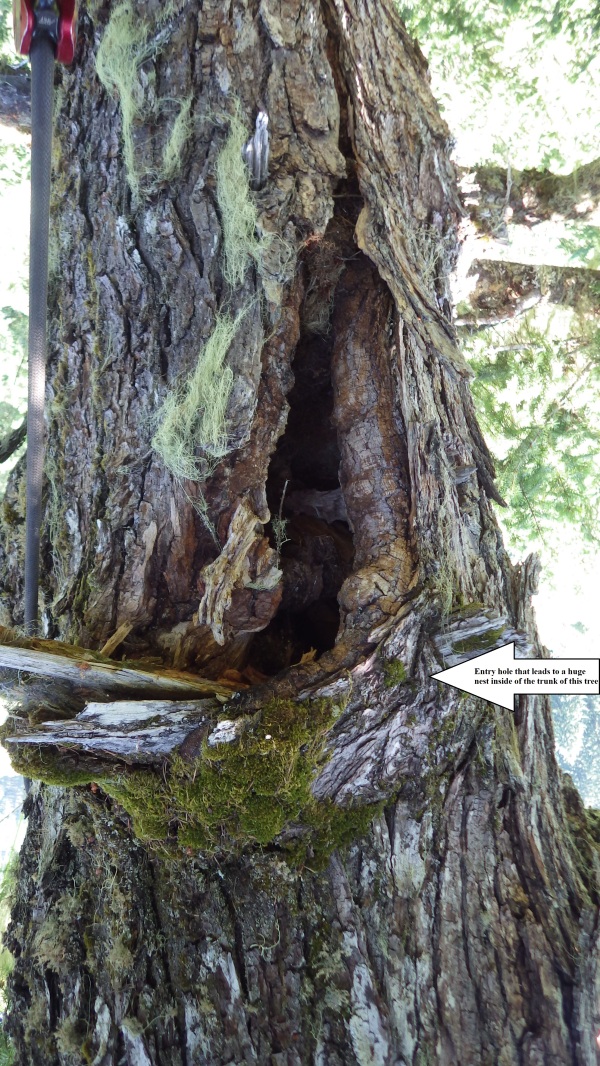A great lecture on the natural history of the red tree vole with some great wildlife cam footage of the red tree vole foraging.
NEST in new sale outside of Sweet Home
QMS_Master_All_Units_topo_6.5.19(1)
You can click on this link to get the map. we will be in unit 166
44°30’08.6″N 122°06’23.2″W
Contact the nest email to get directions Or use the map. Its geo tagged so it will work in Avenza. Confirmed dates: Aug 17-21
Possible others (not confirmed): Aug 23-27 Aug 30th to sept 3
NEST tree climbing workshop in June

Description
Surveys for red tree vole (Arborimus longicaudus) nests require tree climbing because the species is a highly specialized arboreal rodent that live in the tree canopy of coniferous forests in western Oregon and northwestern California. Tree voles are associated with old coniferous forest (≥80 years old) that are structurally complex, but are often found in young forests (<80 years old) especially in unthinned young forests adjacent to old forest. Throughout much of their range tree voles primarily forage and nest in Douglas-fir (Pseudotsuga menziesii) and occasionally in grand fir (Abies grandis). The exception is in the Sitka spruce (Picea sitchensis) zone along coast of Oregon where tree voles primarily nest in and feed on Sitka spruce and western hemlock (Tsuga heterophylla). This photographic nest guide is intended to aid identification and classification of tree vole sign with minimal impact on nests. The primary users of this guide will be tree climbers who search for distinctive tree vole nest material that indicates presence.
PDF download here: https://www.fs.fed.us/pnw/pubs/journals/pnw_2017_lesmeister001.pdf
NEST in Eugene weekly about Quartz sale
Back in 2014, 2015 and 2016, NEST surveyed the quartz timber sale. The USFS decided to not protect the tree vole populations discovered by NEST and are now planning timber sales. The article below covers the latest developments on the Quartz project and NEST’s involvement.
Conservation Groups Sue Forest Service Over Cottage Grove Timber Sale
Come check out the NEST table at PIELC conference!

This March 1-4th, in Eugene Oregon, NEST will be tabling at the PIELC environmental law conference. Please stop at our table to say hi, learn about NEST, share information, or talk about volunteering with us during the field season.
17 more red tree vole Nests in the Picket West sale.
The map below shows new nest discoveries in unit 3-5. The green circles are new active nests and the blue flags are nests previously found earlier in the summer (active and inactive). This survey effort shows complete colonization of unit 3-5 and it should remain untouched in order to provide for the persistence of the red tree vole in low elevation old growth stands such as those represented in unit 3-5 (typical elevation is 1800-2000 feet). 
Below are some great photos taken inside unit 3-5

An old growth madrone that survived a fire about 100 years ago.

The town of Selma can be seen from the unit. It’s about 5 minutes from the main intersection.

“Chicken of the Woods” edible mushroom. The stand of nearly 1 square mile of intact forest provides many opportunities for recreation and mushroom hunting.

The tree in the background is a sugar pine. The ground surveyor selected this tree and NOT the old growth douglas fir. The sugar pine had a visible nest but it’s more likely that the old growth douglas fir has a tree vole nest. The visible nest in the sugar pine is probably a squirrel nest. The ground surveyor, lead by biologist Jason Reilley, refused to mark old growth douglas firs unless there was a visible nest. RTV nests can be as small as the size of a fist. It’s unlikely to see them in the massive canopies of OG trees, especially if they are concealed in the trees cavities. That’s why the ground survey was flawed and lead to missing a lot of RTV nests.

The Pickett West Forest Management Project is a massive timber sale and fuel reduction project planned by the Grants Pass BLM. The planning area stretches across 200,000 acres, from North Applegate and Murphy, to Wilderville, Selma, and north through the Hellgate Canyon Recreation Area, to Galice and Graves Creek on the Rogue River. Numerous important wildlands are found within the planning area, including Kerby Peak, Round Top Mountain and tributaries of the Wild and Scenic Rogue River.
The BLM is proposing regeneration logging in some areas. Similar to clearcut logging, the purpose of regeneration logging is to remove the current overstory canopy in stands over 150 years old and regenerate a young plantation-like stand. The practice badly damages habitat values while drastically increasing fuel hazards. (information taken from http://www.applegateneighborhood.net/pickettwest-timber-sale/)
Nest surveyed in a fair amount of the units in each of the geographical locations, with a emphasis on the units located near Selma, OR. This timber sale includes units that NEST had previously surveyed back in 2006. Some of the units had been previously surveyed by contractors in 2006 and 2000.
This time around the BLM did an even less than adequate job at locating tree vole nests (than in 2006) because of the way in which the BLM biologist and the government contractor interpreted and implemented the survey protocol. There were numerous flaws to their implementation of the survey protocol that lead to a gross under representation of the quantity of tree vole nest sites in most of the project area. Their biggest flaws were that they excluded climbing individual habitat trees without visible nests (selecting remnants for individual tree examination), that they choose not to re-climb previously discovered nest trees from 2000 and 2006, and they did not conduct 100m searches around active tree vole nests following the 2012 tree vole survey protocol.
Ground-based surveys can only detect lower, larger visible nests in mixed age stands (including those with legacy trees). Using ground based surveys without selecting habitat trees for individual tree examination resulted in an underestimation of tree vole nests in the project area. Northwest Ecosystem Survey Team’s surveys data dating back to 2001 and research done on the red tree vole has shown that relying on ground based surveys in stands with legacy trees leads to an underestimation of active tree vole nests. In the Pickett West Project NEST’s surveys identified 62 red tree vole nests in trees that were not visible from the ground (out of 77 total nest trees found). These nests, not visible from the ground, are often in the broken tops, in dead limb cavities, or too small or high up to be seen from the ground. A tree vole nest can be as small as the size of a fist or as large as a few feet in diameter. A small nest on top of a branch or a medium sized nest in the upper third of the canopy usually cannot be seen from the ground. The nests in broken top cavities are often large multi-generational nests. Cavity nests that are less likely to be predated because cavity nests provide more protection than nests out on branches. These cavity nests are also well protected against the elements so often there will be a multitude of layers created by each successive generation. Cavity nests are likely to be important to the persistence of a given tree vole population at the local level.
Our results from surveys dating back to 2001 are in agreement with leading tree vole researcher, James Swingle’s (2005) statements that “-Comparisons of nests located by visual searches from the ground versus nests located by following radiocollared voles indicated that many active nests could not be seen from the ground, and that nests located by visual searches were biased towards large nests” and “Our results also indicated that a management approach based only on the protection of active nests detected during ground based surveys will result in the destruction of large numbers of nests not detectable from the ground.” Despite providing evidence to the BLM about the flawed implementation of the survey protocol back in 2006 (The BLM biologist was provided a copy of the paper published by Swingle) , then a reminder of it in 2014, The BLM still instructed the ground surveyor to only select nests visible from the ground. Sometimes the surveyor would select very unlikely trees like a sugar pine without connecting douglas firs (there is no evidence that tree voles come to the ground to forage) or an obvious squirrel nest in a small tree that wasn’t even inside the unit (when there were numerous old growth, structurally complex, remnant trees available for selection inside the unit). Take a look at the pictures below, which tree would you select, the small tree outside the unit, across the road in a previously thinned stand? Or the structurally complex old growth remnant with a dead top that has cavities? 

In the above photo in the close up of the tree from the ground, you can see white transect flagging. This indicates that the ground surveyor had to pass by the remnant tree where NEST surveyors located an active tree vole nest. The ground surveyor definitely saw this tree, but chose not to mark it and instead he marked the small tree outside the unit. This is not an outlier. The ground surveyor consistently skipped over high quality structurally complex trees while marking smaller trees that had visible nests in their lower 3rd of their canopy.
Another serious flaw that lead to gross under representation of the active tree vole colonies present in the Pickett West timber Sale was the BLM’s decision to not re-survey red tree vole nest trees that were discovered in 2000 and 2006. NEST climbers re-climbed trees that were climbed in 2006 and found that there was still tree vole activity in many the trees that had previous tree vole activity. One surveyor re-climbed trees in unit 3-5 (previously known as unit 3-1 and part of the Anderson West Timber Sale) that had tree vole nests in 2000 and/or 2006. On 20 May 2017 that climber resurveyed 3 legacy trees that had tree vole nests in 2006. In 2006, Northwest Ecosystem Survey team surveyors selected these trees because of their complex structure, including cavities. All 3 trees had evidence of tree vole activity, 2 had red tree vole nests (1 very recent active and one with mixed evidence, possibly active but was labeled inactive) . One of those 3 nest trees is a large diameter legacy old-growth tree with very large diameter branches, some of which were dead. The climber found several cavity nests in the dead branches, one of which had fresh green cuttings. In the second nest tree the nest climber located a tree vole nest with some desiccated cuttings and yellow ducts. For the last of those 3 trees re-climbed on that day the surveyor could only find tan resin ducts on branches, but no nests. Tree vole nests trees in such trees would not be located by relying on ground based surveys. These re-surveys of trees containing previously discovered nests confirms the logic in the survey protocol that protects inactive nests because they are likely to be re-occupied. It also shows that the BLM should have ordered re-climbs of all trees that had shown red tree vole activity in the past.
The survey protocol gives protection to inactive nests on the basis that tree vole nests are often re-occupied by other red tree voles. Therefore all inactive nests within 100m of an active nest are included in the same habitat buffer. If old nests are often re-occupied, then it makes sense that if a biologist truly wanted to know the extent of a red tree vole colony they would re-climb all trees with tree vole activity in the past. The reason given by the BLM biologists why they don’t re-climb trees is that they believe that the ground surveyors will discover any re-occupation. This is flawed logic because in 2006, the contractors working for Steve Holmes Forestry who had the contract in 2006 selected remnant trees without visible nests. Also in 2006, Northwest Ecosystem Survey Team, discovered over 30 red tree vole nests in unit 3-5 (previously known as 3-1 in the Anderson West timber sale) that were not considered by the Bureau of Land Management nor detected by the contract ground surveyors. Most of these nest trees in which NEST located tree vole nests were old-growth legacy trees without visible nests. The red tree vole survey has been re-written to include guidance on single-tree surveys. NEST argues that re-occupation of red tree vole nest trees located in legacy trees will not be discovered using only ground-based surveys. The BLM biologist believes that he can ignore the past surveys and that his approach of sending in a ground surveyor to only mark trees with visible nests will be enough to locate tree vole colonies, but NEST’s recent discovery of 62 nests that were not visible from the ground illustrates just how flawed that idea is.
One of the last major flaws that lead to the under representation of how many tree voles there are in the Pickett West project area is the fact that the BLM biologist did not do any 100 meter searches around known tree vole nest trees. 100m searches are a more intensive search around a nest tree in order to find out the extent of a tree vole colony. Normally, biologists order 100m searches around trees because the initial ground survey,as designed, only covers 80% of the unit. So 100m searches often locate more potential trees for climbing and can lead to more tree vole nests being found. The BLM biologist did not have the contract climber do any 100m searches thereby greatly limiting the number of nest trees found. This, coupled with not selecting quality habitat trees, severely crippled the survey effort.
The BLM biologist may think that his ground surveys and subsequent climbs were enough to “survey to protocol” but NEST doesn’t agree that the project site was surveyed to protocol due to the numerous flaws outlined above, the biggest one being not surveying old growth remnant trees without visible nests. The current survey protocol gives guidelines for biologists to do individual tree examination or sampling . The protocol itself states ”The primary objective of the protocol is to determine the presence of active red tree vole nests.” The protocol recognizes that some old-growth conifer stands have conditions that make it exceptionally difficult to detect red tree vole nests from the ground. Many of the stands in the Pickett West Timber Sale have conditions that would make it extremely difficult to determine the presence of active red tree vole nests without doing some type of sampling. The perfect trees for sampling are old-growth legacy trees. Many units in the Pickett West Timber Sale contain very tall old-growth legacy trees with an under-story of younger more densely packed trees. It’s almost impossible to see into these legacy trees and the current protocol gives advice on what trees to select for sampling “ trees to be climbed or examined should include trees with large limbs, defects, cavities, broken tops, mistletoe brooms, or other features that may provide for stable nest structures.” NEST surveyors have told the Bureau of Land management biologist this on several occasions, dating back to 2006. Most wildlife biologists that work for the Bureau of Land Management or the United States Forest Service will select remnant trees in stands where they exist (or instruct the ground surveyors to do so). In fact, so many are doing so, that often NEST will not need to go to sales where such biologists have done the surveys because they already surveyed the trees that NEST surveyors would have selected for climbing (unlike in the Pickett West project where the BLM ignored some of the best habitat and selected a lot of unlikely nest trees just because they had a visible arboreal structure).
The method that NEST uses, that of climbing old-growth legacy trees in stands that contain a younger forest with legacy trees has shown that the ground surveyor is missing a disproportionate amount of red tree vole nests. This and research done by the leading experts in tree vole ecology has shown that only climbing visible nests from the ground to determine red tree vole colonization is flawed and unscientific. NEST believes that there are a few things the BLM can do in the Pickett West timber sale to rectify the inadequate survey for tree voles in the project area:
1. Accept and verify the data submitted by Northwest Ecosystem Survey Team and use it to create new habitat buffers and when appropriate add to habitat buffers already created.
2. Conduct 100m searches around ALL red tree vole nest trees and select and give precedence to climbing remnants even if they don’t have visible nests. Preferably these 100m searches would be performed by a competent surveyor who is capable of identifying such habitat trees and able to climb them to the top (climbing to the top is very important because research has shown that most tree vole nests exist in the upper 3rd of the canopy, not the lower 3rd).
Just doing these two suggestions would do a lot to remedy the gross under-representation of tree vole colonies present in the Pickett West Timber Sale. However, since NEST was not able to go to every single unit proposed in the Pickett West project we feel that there should be a 2nd survey effort to identify units that contain old growth remnants and then climb a certain percentage of them (giving priority to the most structurally complex ones, like those with broken tops, dead tops and ones likely to have cavities). Until then, the BLM’s survey effort should be considered flawed and not accurate enough to allow for the Pickett West project to continue on as planned.

Can you find the tree vole in this picture?
Please contact us if you would like to survey. This year’s season has started early and is likely to go well into the fall. There may be periods where we are not in the field. 
Close up of a red tree vole nest’s entrance. You can really make out the resins ducts.
NEST surveyors efforts lead to the preservation of about 27 acres of red tree vole habitat in the Lang Dam timber sale.
Lang Dam is located near Cougar Hot Springs in the McKenzie Ranger district. Nest surveyors spent roughly a week surveying the two units of the timber sale that had decent red tree vole habitat. We found 12 nests and the Forest Service accepted our data and used our information to create red tree vole habitat buffers. Below is a map of the habitat buffers that were created by the U.S.F.S. biologist who is working on the Lang Dam project. 
Below is a picture of one of the nests found at Land Dam. It was a nest inside the cavity of an old growth tree. Units 210 and 220 were a mix of old growth remnant trees (trees that survived a catastrophic event such as fire or disease leading them to be significantly older than the rest of the trees in the stand) and younger forest, possibly 80-100 years old. Those two units had older forest with remnants. 
Below is a picture of the nest that is inside the cavity pictured above:


